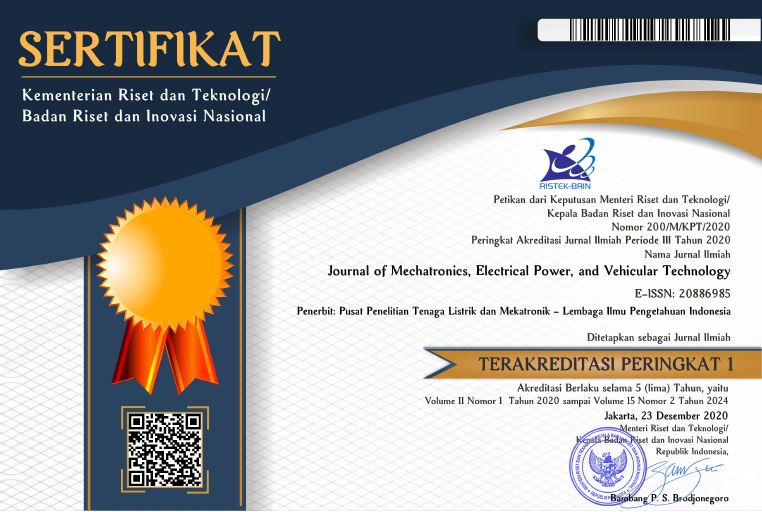Domestic component level analysis for multipurpose autonomous robot
Abstract
Keywords
Full Text:
PDFReferences
S. Andreasson, “Varieties of resource nationalism in Sub Saharan Africa’s energy and minerals markets,” Extr. Ind. Soc., vol. 2, no. 1, pp. 310–319, 2015.
J. D. Wilson, “Understanding resource nationalism : economic dynamics and political institutions political institutions,” Contemp. Polit., vol. 21, no. 4, pp. 399–416, 2015.
I. Ramdoo, “Unpacking local content requirements in the extractive sector: what implications for the global trade and investment frameworks?,” Geneva, 2015.
R. Dobbs, J. Oppenheim, A. Kendall, F. Thompson, M. Bratt, and F. van der Marel, “Reverse the curse : maximizing the potential of resource-driven economies,” 2013.
J. S. Ovadia, “Local content policies and petro-development in Sub-Saharan Africa : a comparative analysis,” Resour. Policy, vol. 49, pp. 20–30, 2016.
C. Kwon and B. G. Chun, “Local content requirement under vertical,” Rev. Dev. Econ., vol. 13, no. 1, pp. 111–124, 2009.
F. M. Veloso, “Understanding local content decisions : economic analysis and an application to the automotive industry,” J. Reg. Sci., vol. 46, no. 4, pp. 747–772, 2006.
A. Niran and A. Abd, “The role of local content policy in local value creation in Nigeria’s oil industry : a structural equation modeling (SEM) approach,” Resour. Policy, vol. 49, pp. 61–73, 2016.
J. U. Monday, “Local content policy , human capital development and sustainable business performance in the Nigerian oil and gas industry,” J. Manag. Sustain., vol. 5, no. 1, pp. 75–83, 2015.
S. Lange and A. Kinyondo, “Resource nationalism and local content in Tanzania : experiences from mining and consequences for the petroleum sector,” Extr. Ind. Soc., vol. 3, no. 4, pp. 1095–1104, 2016.
I. Febijanto et al., “Domestic component level assessment for a salt factory and a salt production,” Maj. Ilm. Pengkaj. Ind., vol. 15, no. 1, pp. 50–58, 2021.
A. Windaru and A. H. Budiman, “Cost generation analysis of small scale geothermal power plant,” J. Energi Dan Lingkung., vol. 13, no. 1, pp. 47–52, 2017.
B. Sucahyo, D. L. H, R. Ridlo, T. P. R, and E. R. S, “Kajian teknologi pemanfaatan biogas pome (palm oil mill effluent) ke boiler,” Maj. Ilm. Pengkaj. Ind., vol. 13, no. 1, pp. 43–54, 2019.
T. Hidayat and B. Ma’ruf, “Improvement analysis of component local content on domestic new building,” Wave J. Ilm. Teknol. Marit., vol. 10, no. 2, pp. 61–66, 2016.
Ministry of State Secretariat, Presidential regulation no. 55 of 2019 concerning the acceleration of the battery electric vehicle program for road transportation. Indonesia, 2019.
S. Asadi, B. Madjid, M. Asadi, and T. Oliver, “Autonomous vehicles : challenges, opportunities, and future implications for transportation policies,” J. Mod. Transp., vol. 24, no. 4, pp. 284–303, 2016.
M. Hirz and B. Walzel, “Sensor and object recognition technologies for self-driving cars,” Comput. Des. Appl., vol. 15, no. 4, pp. 501–508, 2018.
J. H. J. A. Yoganandhan, G. Rajesh Kanna, S. D. Subhash, “Retrospective and prospective application of robots and artificial intelligence in global pandemic and epidemic diseases,” Vacunas, vol. 22, no. 2, pp. 98–105, 2021.
S. Boopathi, A. B. Poma, and P. Kolandaivel, “Novel 2019 coronavirus structure , mechanism of action, antiviral drug promises and rule out against its treatment,” J. Biomol. Struct. Dyn., vol. 39, no. 9, pp. 3409–3418, 2021.
Y. Shen et al., “Robots under Covid-19 pandemic : a comprehensive survey,” IEEE Access, vol. 9, pp. 1590–1615, 2021.
M. Biasin et al., “UV-C irradiation is highly effective in inactivating Sars-Cov-2 replication,” Sci. Rep., vol. 11, no. 1, p. 6260, 2021.
D. Welch et al., “Far-UVC light : a new tool to control the spread of airborne-mediated microbial diseases,” Sci. Rep., vol. 8, no. 1, p. 2752, 2018.
M. Buonanno, D. Welch, I. Sh, and D. J. Brenner, “Far-UVC light (222 nm) efficiently and safely inactivates airborne human coronaviruses,” Sci. Rep., vol. 10, no. 1, p. 10285, 2020.
B. Ramalingam et al., “A human support robot for the cleaning and maintenance of door handles using a deep-learning,” Sensors, vol. 20, no. 12: 3543, 2020.
C. J. Donskey, “Does improving surface cleaning and disinfection reduce health care-associated infections?,” Am. J. Infect. Control, vol. 41, no. 5, pp. S12–S19, 2013.
C. L. Passaretti et al., “An evaluation of environmental decontamination with hydrogen peroxide vapor for reducing the risk of patient acquisition of multidrug-resistant organisms,” Clin. Infect. Dis., vol. 56, no. 1, pp. 27–35, 2013.
G. Adamides, C. Katsanos, G. Christou, M. Xenos, G. Papadavid, and T. Hadzilacos, “User interface considerations for telerobotics : the case of an agricultural robot sprayer,” Second Int. Conf. Remote Sens. Geoinf. Environ., vol. 9229, 2014.
C. A. A. Calderon, E. R. Mohan, and B. S. Ng, “Development of a hospital mobile platform for logistics tasks,” Digit. Commun. Networks, vol. 1, no. 2, pp. 102–111, 2015.
A. R. Putri and P. N. Rahayu, “Food warmer system based on DHT-22,” J. Adv. Res. Electr. Eng., vol. 4, no. 1, pp. 56–63, 2020.
L. Grasse, S. J. Boutros, and M. S. Tata, “Speech interaction to control a hands-free delivery robot for high-risk health care scenarios,” Front. Robot. AI, vol. 8, p. 40, 2021.
H. M. Saputra et al., “Robot otonom multiguna,” P00202006900, 2020.
C. H. A. H. B. Baskoro, H. M. Saputra, M. Mirdanies, V. Susanti, M. F. Radzi, and R. I. A. Aziz, “An autonomous mobile robot platform for medical purpose,” in 2020 International Conference on Sustainable Energy Engineering and Application (ICSEEA), 2020, pp. 41–44.
Ministry of Industry Indonesia, Regulation of the minister of industry of the Republic of Indonesia number 22 of 2020 concerning provisions and procedures for calculation of the value of domestic component levels for electronic and telematics products. Indonesia, 2020.
Ministry of Industry Indonesia, “Strategic plan for 2020 to 2024 - Ministry of Industry,” Jakarta, 2020.
Article Metrics
Metrics powered by PLOS ALM
Refbacks
- There are currently no refbacks.
Copyright (c) 2021 Journal of Mechatronics, Electrical Power, and Vehicular Technology

This work is licensed under a Creative Commons Attribution-NonCommercial-ShareAlike 4.0 International License.





















